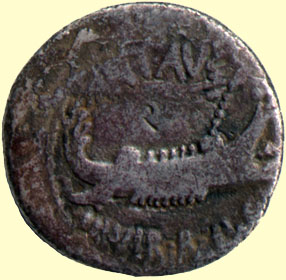 Contents -
Previous Article -
Next Article
Contents -
Previous Article -
Next Article
The warships used by the Romans were adapted from the Greek triremes and quinquiremes. The quinquireme had oars on each side set in banks of five. The arrangement of rowers on the benches was somewhat complicated, as these were long, low, narrow ships without much room to move about. Yet, the best research that scholars can point to tells us that there were three levels of benches, with two rowers on the top bench per side, two in the middle level per side, and only one strong rower on each side of each bottom bench. They had to row in unison and this skill required long weeks of practice to develop. Otherwise, the seamen would foul each others’oars, leaving the ship a tangled mess with broken oars that would be easy prey for an enemy. In fact, a favorite fighting tactic was to make a high speed pass down the side of an enemy warship, shearing off its oars and maiming the crew in the process. Of course, the seamen who tried this would have to be well practiced in moving their own oars out of the way if they didn’t want the destruction to be mutual.
The Romans, as a civilization, were not great scientists or inventors. Instead, they excelled at taking an invention and developing it to perfection and applying it to solve a practical problem. Often it would be one of little practical use that was still at the toy stage, but perhaps more often it was a weapon whose performance was only mediocre before they applied their nimble minds and hands to it. Such it was with their warships. They took Greek and Phoenician designs and beefed up the gunwales and added fighting towers and movable gangplanks for grappling with and boarding enemy vessels. Like the Greek and Phoenician designs, Roman warships had a sharp, reinforced beak or ram used for puncturing an enemy hull and a high, curved stern at the back. The reverse of a coin struck by the Gallic usurper Postumus clearly shows the stern of a Roman warship, along with the shelter for the steersman and the rowers at their benches.
During the reign of Gallienus, the Goths captured a fleet of ships and kept the Mediterranean lands in terror with their piratical raids.
During the late Third and Fourth Centuries, Roman oared warships patrolled the English Channel, sweeping the sea of pirates and Saxon raiders under the command of the Count of the Saxon Shore. It was this strong British Fleet that Carausius used to rebel and seize the island province of Roman Britain. This same fleet enabled Carausius and his successor Allectus to hold their breakaway empire for ten years.
The Byzantines, inheritors of the Eastern Roman Empire and Rome's fleet and what little naval heritage she possessed, were quite a bit more innovative in the area of naval technology. Under the strong emperors, the Byzantine navy became the greatest in the Mediterranean and the pride of the empire. The Byzantine navy did not decline until the Venetian navy reached its peak when superiority in sea power once again emanated from the Italian peninsula.
Go to next article:
Go back to previous article:
Return to Table of Contents